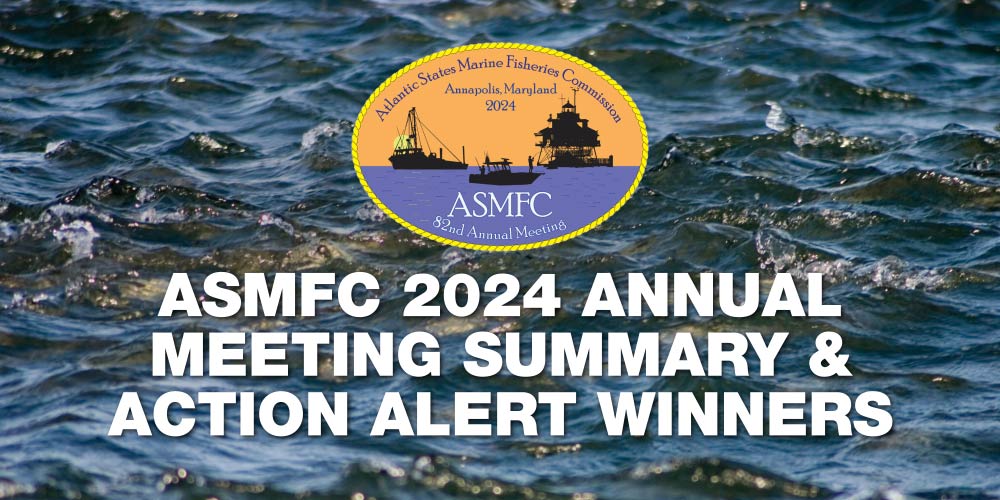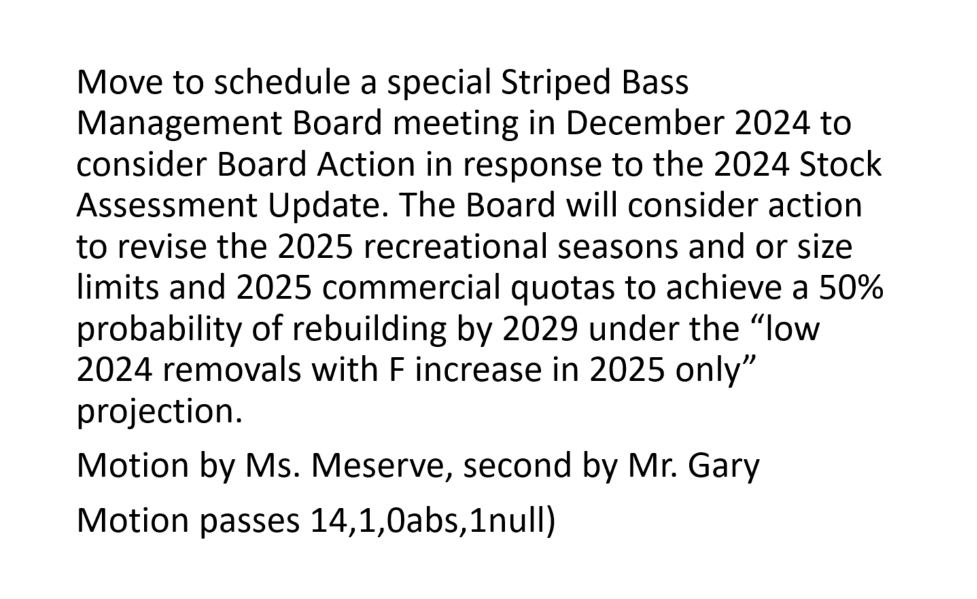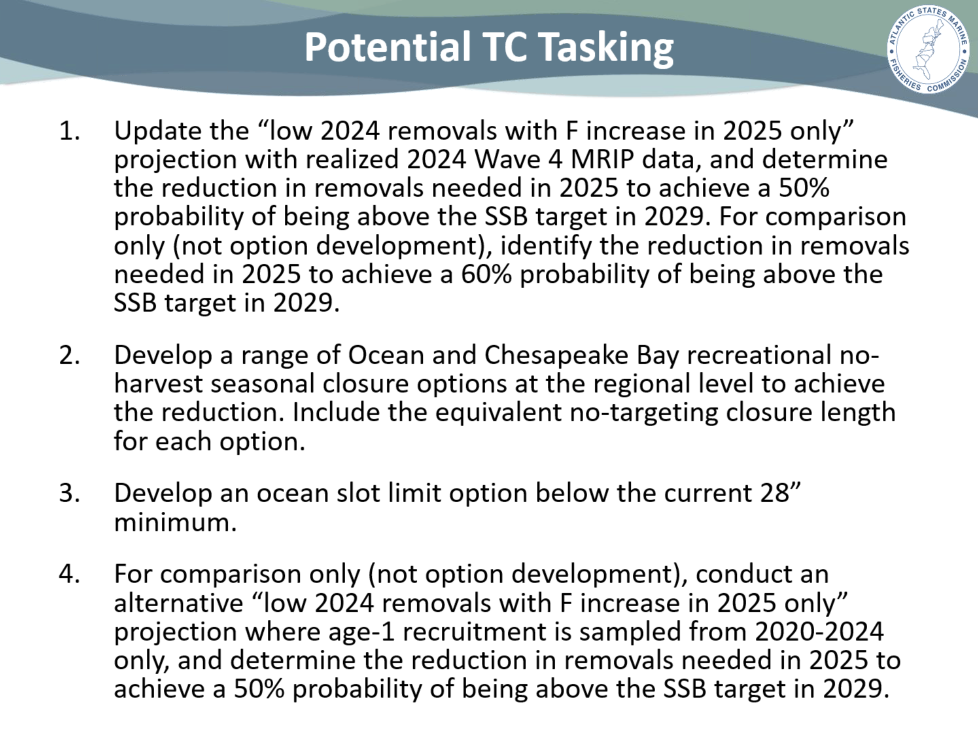ASMFC 2024 Annual Meeting Summary & Action Alert Winners

Last Wednesday, October 23, 2024 the Striped Bass Management Board met durning the ASMFC 2024 Annual Meeting. It was a six-hour meeting and we came away with mixed feelings.
There are clearly some board members who refuse to admit (publicly) that wild Atlantic striped bass are on the brink of another collapse. Rather than accept their own data and look for solutions, they instead choose to side with constituents who demand the right to not only keep killing fish, but to kill more of them. Representatives of the commercial fishing community and for-hire fleets argued that their demands should take priority over tens of thousands of recreational anglers and the businesses that serve them.
But there were also some board members who, recognizing that the situation facing striped bass is a crisis, expressed frustration with their colleagues who stand in the way of meaningful action. That gives us hope that there will be action in the future. The only question is, will that action happen in time?
Here are some quick takeaways from the meeting:
- The 2024 Stock Assessment update suggests that the stock will not rebuild by the 2029 deadline without the intervention of the board and a further reduction in fishing mortality.
- The stock is currently overfished but not experiencing overfishing in 2024.
- There is some uncertainty around the current assessment due to incomplete MRIP data.
- Research suggests that the mandated use of circle hooks has not improved release mortality as believed.
- The Massachusetts Division of Marine Fisheries/University of Massachusetts study affirmed a 9% overall rate of recreational release mortality, although there needs to be a closer look at regional influence.
- The spawning stock biomass showed a slight improvement as fish from the 2017 year-class reached sexual maturity, but the biomass is also being hit hard by both commercial and recreational harvest. Commissioners expressed concern that the lack of spawning success means that biomass will quickly decline without a significant reduction in harvest.
- A lot is riding on the 2018 year-class as most of those fish have now likely grown to where they have reached the coastal recreational slot and commercial size limit.
It’s easy to see that these findings add up to bad news for the fish that remain in the ocean and on which the future depends. And while policy change was not on the October agenda, a motion passed to hold an emergency meeting in December to debate and, hopefully, take action for 2025 aimed at effecting a meaningful reduction in harvest.

Unfortunately, the Maryland and Delaware delegations made the dubious contention that it is already too late for them to change regulations for their commercial fisheries. Such arguments were, in our opinion, pre-emptive and intended as damage control to show their friends that they are fighting for their interests. We’ll see how it plays out since any cuts to harvest should be equitable across all user groups.
It is worth noting that the idea of a moratorium, which we have pushed for since 2021 and the debate over Amendment 7, did show up in subtle ways. Whereas in 2021 the reactions to our proposal were hostile (to put it mildly), there were signals that, if things do not improve measurably by this time next year, such an idea might be reasonable.
What does that mean for Stripers Forever?
Thanks to the steadfast pressure that our members have put on the ASMFC through public comments, we have clearly changed the conversation to the point where some delegates have left the door ajar. Comments received by the ASMFC prior to this meeting were overwhelmingly supportive of an equitable harvest moratorium, and we believe that some influential voices in the fishing community are coming to grips with the idea that a moratorium is likely the only arrow left in the ASMFC’s management quiver that has a chance of hitting the target.
So where do we go from here?
There will likely be a call for public comments prior to the December meeting and we will let you know at that time what we think the best response will be. Please keep your eyes open for those messages. The TC (technical committee) will also be working on some assignments from the board. The information gained from the below will help guide the board in deciding the best action plan to ensure a rebuilding of the stock by 2029. Unfortunately, the board seems satisfied with a 50% or at best 60% chance of rebuilding by 2029. So, the fate of stock and the economy which it supports is decided by a coin toss. Not the way we would do business and in our humble opinion, a losing bet.

In the meantime, thank you for your support and for your concern for the future of wild Atlantic striped bass.
This is the statement we read at the outset of the meeting:
Recreational slot and commercial size limits focused on harvesting breeding-sized fish.
Gill nets in the Bay—legal and illegal—killing fish indiscriminately.
Environmental conditions squeezing the spawning window so narrow that there is no room for error.
Mycobacteriosis. Predation. Invasive species. Warming water. Lack of forage.
It adds up to a crisis for striped bass. And yet, as with every other meeting of the striped bass technical committee, there will be lots of numbers and charts and formulas cited as sleight of hand to convince the public that the fisheries managers have things under control and that we just aren’t smart enough understand. And yet we’ve had a quarter-century of the smartest people in the room presiding over a steady decline in the striped bass population.
In 2021 I was among the voices calling for the ASMFC to do something bold and initiate a ten-year recreational and commercial harvest moratorium. I, and many others, asked that the fishery be shut down long enough to give striped bass a chance to recover and achieve the abundance and healthy age stratification the Commission claims are its management goals.
And now, after six straight years of spawning failure, this meeting will likely conclude with more of the same: incremental tweaks to a ten-year recovery plan that is entering its fourth year with no indication that improvement is imminent, and the remaining breeding population producing numbers insufficient to fill the reproductive pipeline.
What will it take for the ASMFC to find the courage to do the right thing and shut the fishery down for the sake of the future of striped bass? Pausing the commercial harvest and imposing a zero-bag limit for recreational anglers is the last, best hope for recovery.
If the Commission is serious about achieving its goals, an equitable harvest moratorium needs to be a part of the debate.
ACTION ALERT – WINNERS

A BIG THANK YOU to those who took the time to be part of the process!
Winners of the 5 limited edition SFxSLP striped bass bracelets have been notified via email. Once shipping addresses have been confirmed bracelets will be shipped.
ADDITIONAL LINKS
- ASMFC 2024 Annual Meeting: News Release 10/24/24 – Atlantic Striped Bass Stock Assessment Update Finds Resource Remains Overfished With A Less Than 50% Chance of Rebuilding by 2029 (PDF)
- ASMFC 2024 Annual Meeting: Presentations (PDF)
- ASMFC 2024 Annual Meeting: Audio/Video Meeting Recording (YouTube)







